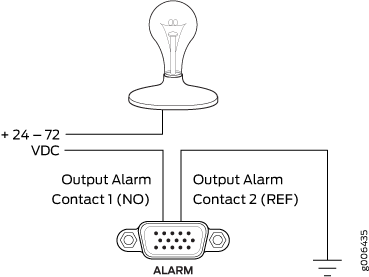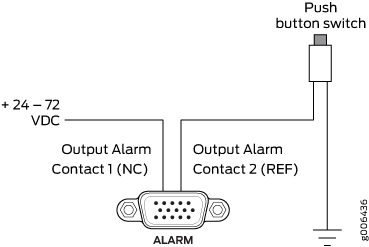ACX2200 Chassis Components
Front Panel of an ACX2200 Router
The front panel of an ACX2200 router consists of the following components (see Figure 2 and Figure 1):
Chassis status LED labeled SYS
Two USB ports for upgrading Junos OS
Management Ethernet port labeled MGMT
Console or auxiliary port labeled CONSOLE/AUX
Alarm contact port labeled ALARM—accepts a DE-15 alarm cable
External clocking input port labeled EXT REF CLK IN
External clocking ports supporting 1PPS and 10MHz input and output
Network ports and corresponding status LEDs:
Four Gigabit Ethernet RJ-45 ports labeled 0/0/0 through 0/0/3
Four combination ports (COMBO PORTS): either four Gigabit Ethernet RJ-45 ports or four Gigabit Ethernet SFP ports, labeled 0/1/0 through 0/1/3.
Two Gigabit Ethernet (GE) SFP ports, labeled 0/2/0 and 0/2/1, that accept transceivers
Two 10-Gigabit Ethernet (XE) ports, labeled 0/3/0 and 0/3/1, that accept SFP+ transceivers

1 — AC inlets | 8 — Ten-Gigabit Ethernet SFP+ ports |
2 — Management Ethernet port | 9 — Gigabit Ethernet SFP ports |
3 — Console or auxiliary port | 10 — Combination Gigabit Ethernet SFP ports |
4 — Alarm contact port | 11 — External clocking ports |
5 — RJ-45 Gigabit Ethernet network ports | 12 — External clocking input port |
6 — Combination Gigabit Ethernet ports | 13 — USB ports |
7 — ESD point | 14 — System LED |

1 — DC terminal | 9 — Gigabit Ethernet SFP ports |
2 — Management Ethernet port | 10 — Combination Gigabit Ethernet SFP ports |
3 — Console or auxiliary port | 11 — External clocking ports |
4 — Alarm contact port | 12 — External clocking input port |
5 — RJ-45 Gigabit Ethernet network ports | 13 — USB ports |
6 — Combination Gigabit Ethernet ports | 14 — System LED |
7 — ESD point | 15 — Grounding terminal |
8 — Ten-Gigabit Ethernet SFP+ ports |
Uplink Ports on ACX2200 Routers
You can find information about the pluggable transceivers supported on your Juniper Networks device by using the Hardware Compatibility Tool. In addition to transceiver and connector type, the optical and cable characteristics—where applicable—are documented for each transceiver. The Hardware Compatibility Tool allows you to search by product, displaying all the transceivers supported on that device, or category, displaying all the transceivers by interface speed or type. The Hardware Compatibility Tool is located at https://apps.juniper.net/hct/.
The list of supported transceivers for the ACX2200 is located at https://pathfinder.juniper.net/hct/product/#prd=ACX2200.
The following ports are supported on ACX2200 routers:
Gigabit Ethernet RJ-45 Ports
Each ACX2200 router has eight Gigabit Ethernet RJ-45 ports. Table 1 describes the ports in more detail.
Feature |
Description |
|---|---|
Supported standards |
10/100/1000BASE-T |
Cable |
Category 5 |
Connector |
RJ-45 |
Port numbering (hardware) |
0/0/0 through 0/0/3 and 0/1/0 through 0/1/3 |
Port numbering (software) |
|
Gigabit Ethernet SFP Ports
The GE ports described in Table 2 support small form-factor pluggable (SFP) transceivers.
You can use Gigabit Ethernet transceivers in the GE ports, or you can use 10-Gigabit Ethernet transceivers in the XE ports. Use one set of ports at a time.
Feature |
Description |
|---|---|
Supported standards |
See the Hardware Compatibility Tool for the specifications of transceivers supported on the ACX2200. The list of supported transceivers for the ACX2200 is located at https://pathfinder.juniper.net/hct/product/#prd=ACX2200. |
Cable |
|
Connector |
|
Port numbering (hardware) |
0/1/0 through 0/1/3 and 0/2/0 through 0/2/1 |
Port numbering (software) |
|
10-Gigabit Ethernet SFP+ Ports
The XE ports described in Table 3 support SFP+ transceivers.
You can use Gigabit Ethernet transceivers in the GE ports, or you can use 10-Gigabit Ethernet transceivers in the XE ports. Use one set of ports at a time.
Feature |
Description |
|---|---|
Supported standards |
See the Hardware Compatibility Tool for the specifications of transceivers supported on the ACX2200. The list of supported transceivers for the ACX2200 is located at https://pathfinder.juniper.net/hct/product/#prd=ACX2200. |
Cable |
|
Connector |
|
Port numbering (hardware) |
0/3/0 and 0/3/1 |
Port numbering (software) |
|
See Also
Alarm Contact Port on the ACX2200 Router
The ACX2200 router has four external alarm contacts (also known as potential free contacts) for connecting the router to external alarm devices. The port labeled ALARM uses a 15-pin D-type connector. The external alarm contact has 15 pins that accept a single core wire from external alarm devices. A DE15 alarm cable is required to connect the ACX2200 router to external alarm devices. Use the gauge wire appropriate for the external device that you are connecting.
Whenever a system condition triggers an alarm, the alarm relay contacts are activated, which in turn activates the external alarm devices. The alarm setting is open or closed.
You can connect and configure two output alarms and four input alarms. Two additional output alarms are reserved and are used to indicate major and minor system alarms. Each output and input alarm has two contacts for connecting the router to external alarm devices. Contact 1 of each alarm can be configured as Normally Open [NO] or Normally Closed [NC] through the CLI. Contact 2 of each alarm functions as a reference [REF] or negative potential terminal for Contact 1 of the corresponding alarm and provides a current path for external alarm devices. Table 4 describes the functions of the alarm contacts.
Contact Name |
Contact Name |
Function |
|---|---|---|
Contact 1 |
Normally Open (NO) |
Current is not flowing through Contact 1 and Contact 2 [REF] when operating normally. When the current flows, the closed alarm is generated. |
Normally Closed (NC) |
Current is flowing through Contact 1 and Contact 2 [REF] when operating normally. When the current stops flowing, the open alarm is generated. |
|
Contact 2 |
Reference (REF) |
Provides the current path for the external alarm-reporting device and functions as a reference or negative potential terminal for Contact 1. |
Figure 3 shows an example of a wiring diagram for a simple output alarm-reporting device. In this case the device is a light bulb that illuminates when the device encounters a condition that activates the red alarm LED and relay contacts. The alarm relay contacts can also be used to activate other devices such as bells or buzzers.

Figure 4 shows an example of a wiring diagram for a simple input alarm-reporting device. In this case the push button switch is an alarm sensor that triggers an input alarm when a door-open condition occurs.

See Also
Clocking Ports on the ACX2200 Router
The clocking ports acquire the clock source and synchronize communication over time-division multiplexing (TDM) interfaces in the router. The clocking ports distribute a synchronized clock signal throughout the router by locking onto a clock signal originating from an internal clock source or by connecting to an external clock source.
The reference clock inputs can be T1/E1 line clocks, Ethernet recovered clocks, IEEE 1588v2 recovered clocks, or xDSL NTU-R timing. Externally available reference clocks are BITS T1/E1 rate clocks, 1 PPS, and 10 MHz. The four SubMiniature B (SMB) connectors and one RJ-48 port on the front panel of the router connect to external clock signal sources. The clocking ports provide the synchronized output clocks from any one of the above reference inputs based on the clock’s priority.
Internal clock sources within the ACX2200 router include:
External building-integrated timing system (BITS) timing port
10-MHz timing connectors (one input and one output)
1.544-MHz/2.048 MHz T1/E1 (RJ-48) ports for timing input or output
1 pulse-per-second (PPS) connectors (one input and one output)
Time-of-Day (TOD) RS232 port
SyncE support on RJ-45/SFP ports as timing input or output
Packet timing (IEEE 1588v2) includes:
Timing input when configured as Ordinary Clock (OC) or Boundary Clock (BC)
Timing output when configured as BC
See Also
LEDs on ACX2200 Routers
The following LEDs are supported on ACX2200 routers:
- System LED on the Front Panel
- Ethernet Port LEDs
- SFP and SFP+ Port LEDs
- Management and Console Port LEDs on the Front Panel
System LED on the Front Panel
One bicolor LED labeled SYS indicates the status of the router. Table 5 describes the system LED in more detail.
Label |
Color |
State |
Description |
|---|---|---|---|
SYS |
Green |
Blinking |
Router is transitioning online. |
On steadily |
Router is functioning normally. |
||
Red |
Blinking |
Router has reported an alarm. |
|
On steadily |
Router has failed. |
Ethernet Port LEDs
The front panel has eight Gigabit Ethernet RJ-45 ports, each with one pair of port LEDs. Table 6 describes the LEDs in more detail.
Name |
Location |
Color |
State |
Description |
|---|---|---|---|---|
Link |
Left |
Green |
On |
Link is online. |
– |
Off |
No link. |
||
RX |
Right |
Green |
Blinking |
The port is receiving data. |
– |
Off |
The port is not receiving data. |
SFP and SFP+ Port LEDs
The front panel has six Gigabit Ethernet SFP ports and two 10-Gigabit Ethernet SFP+ ports, each with one pair of port LEDs. Table 7 describes the LEDs in more detail.
Name |
Location |
Color |
State |
Description |
|---|---|---|---|---|
Link |
Left |
Green |
On |
Link is online. |
– |
Off |
No link. |
||
RX |
Right |
Green |
Blinking |
The port is receiving data. |
– |
Off |
The port is not receiving data. |
Management and Console Port LEDs on the Front Panel
Two RJ-45 ports, labeled MGMT and CONSOLE/AUX, each have a pair of LEDs that display the status of the port. Table 8 describes the LEDs in more detail.
Name |
Location |
Color |
State |
Description |
|---|---|---|---|---|
Link/Activity |
Left |
Green |
On |
Link is online. |
Yellow |
Blinking |
Indicates link activity. |
||
– |
Off |
No link. |
||
RX |
Right |
Green |
Blinking |
The port is receiving data. |
– |
Off |
The port is not receiving data. |
